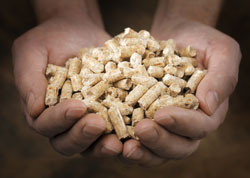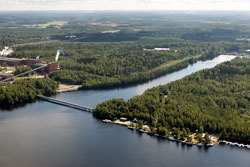The making of a sustainable bio-based economy
 The bio-based economy is currently driven by public policy (especially EU legislation) and private investment. Finland is a forerunner in next-generation renewable fuels and forest-based bioenergy concepts. The Imatra-Lappeenranta Region in southeastern Finland is a central location for the European forestry industry, with several major production sites within a small geographical area. Due to the region’s history and culture of bio-based industry, there is also a concentration of small- and medium-sized enterprises that are experienced in process industry related technology and services. The synergy between existing industries and future possibilities is tangible.
The bio-based economy is currently driven by public policy (especially EU legislation) and private investment. Finland is a forerunner in next-generation renewable fuels and forest-based bioenergy concepts. The Imatra-Lappeenranta Region in southeastern Finland is a central location for the European forestry industry, with several major production sites within a small geographical area. Due to the region’s history and culture of bio-based industry, there is also a concentration of small- and medium-sized enterprises that are experienced in process industry related technology and services. The synergy between existing industries and future possibilities is tangible.
Major forestry industry companies are developing new technological solutions for wood-based fuel production, chemicals and light-weight, bio-based materials. We are witnessing the birth of a new generation of biomass refineries in southeastern Finland. The first industrial-scale plant is currently under construction and others await investment decisions, some of which are expected this year.
One source of new business ideas and inventions is the Lappeenranta University of Technology, which focuses on integrating technology, business and innovative concepts. Its focus areas are sustainable business, clean-tech, new energy systems and Russian business. The university’s Centre for Separation Technologies is dedicated to understanding of the separation phenomenon. The centre is scientifically rigorous and interdisciplinary. A current project involving a wide range of factors in the region is the BIOTULI project, which is financed by the EU. With this project, new business opportunities have been literally extracted from wood. Also, new business models are being analysed, and individual entrepreneurs and companies are involved in examining potential science-to-business projects.
 The university is also in close collaboration with global industrial companies, top international and domestic universities and other educational bodies. The logistics potential of the region is excellent, with extensive roads, railroads, and water ways (through the Saimaa channel from Lake Region to the Baltic Sea). The proximity of Russia, especially the St. Petersburg region, makes cross-border cooperation an integral part of the region’s daily life. Lappeenranta airport offers 200 international flight connections via Riga, Düsseldorf, Milan and Barcelona. The high-speed train from St. Petersburg to Lappeenranta takes only about 90 minutes. The capital of Finland, Helsinki, is 2-2.5 hours away by train.
The university is also in close collaboration with global industrial companies, top international and domestic universities and other educational bodies. The logistics potential of the region is excellent, with extensive roads, railroads, and water ways (through the Saimaa channel from Lake Region to the Baltic Sea). The proximity of Russia, especially the St. Petersburg region, makes cross-border cooperation an integral part of the region’s daily life. Lappeenranta airport offers 200 international flight connections via Riga, Düsseldorf, Milan and Barcelona. The high-speed train from St. Petersburg to Lappeenranta takes only about 90 minutes. The capital of Finland, Helsinki, is 2-2.5 hours away by train.
The proximity of Russia, especially the St. Petersburg region, makes cross-border cooperation an integral part of the region’s daily life.
There are three major borders to the EU and Russia in southeastern Finland, and these enable continuous cross-border traffic and intense collaboration for industrial activities, entrepreneurship, education and tourism. Russian entrepreneurs are also increasingly looking for opportunities to cooperate and establish industry on the Finnish side of the border, which enables them to operate within the EU internal market. Organizations like Imatra Region Development Company and Wirma Lappeenranta offer services in the Russian language. Bio-industry is one of the sectors seeing new industrial sites open in the region.
The industrial base is renewing itself through innovation and new networks. Future bio-refineries will be established in regions that offer proximity to biomass, energy, water and industrial infrastructure. Finland has been undergoing structural change in its industrial activities. It is time to utilise the competence we have to contribute to the building of new business. We invite you to join us in discussing future possibilities of mutual interest.
Laura Peuhkuri, Project director, Imatra Region Development Company, laura.peuhkuri@kehy.fi

